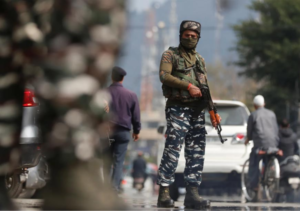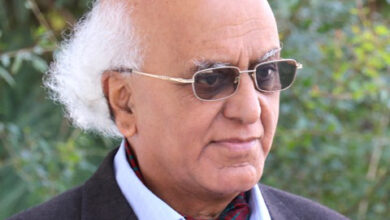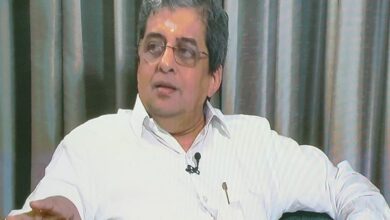Insurrection in the ‘other’ Kashmir

BY SUSHANT SAREEN
The violent uprising in Pakistan occupied Jammu and Kashmir (PoJK), euphemistically called “Azad Jammu and Kashmir” by Pakistanis, has left Pakistan in shock and awe. The scale, spread, and ferocity of the insurrection took the Pakistani authorities by complete surprise. Efforts were made by Islamabad to impose an information blackout on PoJK—the internet was suspended, mainstream electronic media covered the widespread uprising very perfunctorily, talks shows mentioned the developments in passing, and newspaper reportage was very subdued. However, social media clips of the violent clashes with authorities, the strident speeches and slogans bordering on separatism, and the scenes of marchers from different corners of the occupied territory converging at Muzaffarabad, have gone viral all over the world. Of course, the “independent” media of Pakistan downplayed what was perhaps the biggest story to come out of the region in a long while. Curiously, even the Western media, which has been crusading against India’s constitutional reforms in Jammu and Kashmir, pretended that nothing was happening.
Be that as it may, at a time when Balochistan is in turmoil, the Pashtun belt is facing an Islamist insurgency, and there is anger against the Pakistan Army in Punjab, the uprising in PoJK paints a picture of a country which is steadily losing control over its periphery, and facing restiveness even in the hinterland. For most Pakistanis, the real kicker was that on the same day that PoJK was going up in flames, a peaceful and orderly election was taking place in the Union Territory (UT) of Jammu and Kashmir. The juxtaposition of images of India’s UT with Pakistan’s Occupied Territory (OT) couldn’t have been more stark. More than worrying about what the Kashmiris under Pakistan’s control were demanding, the Pakistanis appeared to be more concerned over how the uprising in PoJK buttressed India’s stand on the entire issue. The unkindest cut of all were images of vehicles of Pakistani forces being burnt and the Pakistani flag being brought down at Kohala which is one of the entry points from Pakistani Punjab to PoJK.

The unprecedented uprising in PoJK would have been unimaginable just a few years ago. Because of the conflict with India over Kashmir, PoJK was considered the ‘base camp’ of the insurgency in the Indian UT. The general impression was that this was one set of people who would never go against Pakistan. The society had been radicalised with a multitude of Jihadist groups operating in the area; add to this the massive and oppressive presence of Pakistani security forces and legions of intelligence officials keeping an eye on everyone. During a visit to Muzaffarabad in 2004, the author witnessed first-hand how anyone who dared to speak to the visiting Indian journalists was questioned and monitored. While there were a few who openly rooted for an independent Kashmir, most people preferred to parrot the Pakistani line.
But warning bells had started ringing some time back. According to some Pakistani journalists, the incumbent ‘Prime Minister’ Chaudhry Anwarul Haq had warned lawmakers in Islamabad that the new generation in PoJK was no longer beholden to Pakistan like their forefathers. Anwarul Haq himself represents everything that has gone wrong in PoJK. Like his namesake who was the caretaker Prime Minister of Pakistan, this person is also a nominee of the Pakistan Army. He was selected after the previous ‘PM’ Tanveer Ilyas was ousted from office after being disqualified for contempt of court. Although elected on a Pakistan Tehrik-e-Insaf (PTI) ticket, Anwarul Haq’s elevation split the party. His government was formed with the PTI deserters getting the support of the Pakistan People’s Party (PPP) and Pakistan Muslim League Nawaz (PML-N) lawmakers in the PoJK assembly. Not surprisingly, everyone backing the new regime was rewarded with ministerial or similar offices. In fact, one of the main demands of the agitators is that “perks and privileges of the ruling class and officials (including judges and elites) should be completely eliminated”. The demonstrators are also demanding that no one should be allowed any vehicle above 1300 CC at government expense. The palace coup to install Anwarul Haq has only worsened the governance deficit in PoJK. For years now, the territory has seen a kind of musical chairs of ‘premiers’. The current ‘PM’ is more of a non-resident ‘PM’ who is accused of spending more time in Islamabad than in Muzaffarabad.
The betrayal of the mandate is only one of the triggers, but it is important because the lack of credibility and legitimacy of the political class has meant that all mainstream political parties have become irrelevant because they have been made irrelevant by the military establishment’s heavy-handed handling of the politics of the area. There is no politician who has the standing or influence with the crowds that are on the streets. The people who have spearheaded the entire agitation under the label of Joint Awami Action Committee themselves do not have any control over the crowds.
Bread and butter issues
The insurrection in PoJK is actually not a political agitation in the classical sense. To be sure, the JAAC and its supporters have hash-tagged it as #RightsMovementAJK, but its driving force is existential issues regarding basic necessities. The movement traces its origin to May 2023 when a massive spike in electricity tariffs and rise in prices of flour resulted in angry demonstrations and protests. By August last year, things started boiling over in PoJK. Protestors in Rawalakot burnt their electricity bills and declared a civil disobedience movement. They also demanded that all electricity infrastructure be removed from their fields. Soon the agitation spread to Pakistan and massive protests were seen all over the country. Since then the issue has been simmering. The Pakistani authorities tried to handle it in the traditional way: Ignore it for as long as possible; when some cognisance has to be taken, make assurances that you have no intention of keeping; once the situation is defused, there is no need to deliver. If someone tries to restart the agitation, then crack down hard using the state machinery to browbeat and intimidate the agitators.
This is exactly what was done on 9 May when, to pre-empt the Muzaffarabad March, they detained nearly 70 people. But this move breached the dam of patience and all hell broke loose, leading to clashes in Dadyal. What followed was a civil insurrection across the entire territory that became violent and all efforts to contain it failed. The situation worsened after the Pakistan government deployed the paramilitary rangers who shot three to four protestors in clashes. The scenes following these killings resembled scenes from Palestine, with dead bodies being paraded through the streets and fiery speeches swearing revenge being made.
There is no denying that the bread-and-butter issues are real, even existential. The economic crunch in Pakistan is also being felt in PoJK. But since the area has been used to heavy subsidies on wheat and electricity tariffs, the spike in power rates and in flour prices has been devastating. It is not as if PoJK is being charged more than what electricity consumers in Pakistan are paying. However, the people believe that since the hydropower generated in the occupied territory costs only around PKR 3 per unit, this is the price they should be asked to pay. What they are being asked to pay is close to PKR 60 after adding all the charges, levies, taxes and surcharges. The PoJK people and government also demand that they should be paid a royalty on the power generated. While the going was good, these demands were never an issue. But with the Pakistan economy on the verge of bankruptcy and being forced to address the ever-widening circular debt crisis in the power sector, there isn’t much room left for doling out freebies or highly subsidised power.
Political economy of uprisings
Although the current uprising is predominantly centred around economic issues, there is a deeper underpinning of issues of political economy and political freedoms that appear to be sustaining the movement, which is primarily driven by activists and the trading community but is backed by virtually every section of society. The basis of the angst in PoJK and the other part of Pakistan-occupied Kashmir—Gilgit-Baltistan—is that they have no say in their own governance. While nominally both PoJK and PoGB have ‘elected’ governments, they enjoy no powers. Even a Captain or Major of the Pakistan Army is more powerful and influential than the so-called ‘prime minister’ or ‘chief minister’ of these areas. With Pakistan extending taxes to these regions, the cry of ‘no taxation, without representation’ has formed the bedrock of the agitation. But Pakistan is unable and unwilling to give the people of these two occupied territories any representation in Pakistan’s National Assembly or Senate.
The other problem for Pakistan is that if the government succumbs to the protestors’ demands, then this is a template for others inside Pakistan to seek relief. At a time when Pakistan is going into another International Monetary Fund (IMF) programme, which by all accounts is expected to be an extremely tough one, the government will be forced to administer more bitter pills. There are reports of income tax slabs being changed and pensioners (including ex-servicemen) being taxed. Power tariffs and gas prices are expected to be raised further. As far as the people are concerned, it is an existential crisis because when prices of basic utilities and staples become unaffordable, the people are left with no choice but to hit the streets. What is also at play is that the basic social contract that ties people to the state is under severe strain. When a state weakens and is unable to meet even the basic criteria of the social contract and becomes unresponsive, people are forced to think that they have no option but to resort to violence. For the longest time, the governance model in Pakistan has been to crack the whip and everything and everyone will fall in line. But as the insurrection in PoJK makes clear, the old model is no longer working. People are defying the Pakistan Army and the other law enforcement agencies and, as PoJK has demonstrated, managing to bring the state to its knees. What is more, even groups like the Tehrik-e-Taliban Pakistan and Pashtun nationalists have weighed in in favour of the people of PoJK.
The deeper divide
The events in PoJK have been quite extraordinary. The political aspirations and the economic compulsions that have propelled the insurrection have also highlighted the deepening divide—emotional and psychological—between Pakistan occupied parts of the Indian UT of J&K. This is borne out by the fact that protestors openly declared that while they wouldn’t go hard on local law enforcement, they would go all out to stop the Rangers and Punjab constabulary that were being despatched to the area. And they did force some of these units to retreat, even engaging in pitched battles with them. There was also palpable disgust, disaffection, disillusionment with, and distrust of Pakistan. This is reflected not just in some of the demands but also in the fact that the agitators were not ready to accept verbal or even written assurances. What they demanded was formal notification accepting their demands. Finally, the strong-arm tactics—firing on crowds by Rangers—is something that will cause a lot of bad blood going forward.
Most of all, what Pakistan should be very worried about is that the growing alienation could be make many people of PoJK relook and re-evaluate their options—staying under the yoke of a bankrupt Pakistan or re-uniting the erstwhile state and benefiting from India’s vibrant economy. India’s External Affairs Minister Dr S Jaishankar was recently asked about PoK and the possibility of it returning to India. His answer was instructive. He said that when constitutional reforms were brought in Jammu and Kashmir in 2019, nobody thought it was possible. Cut to the chase, India will be watching developments in PoJK and PoGB very closely and if the opportunity presents itself, then ending Pakistan’s occupation over Indian territory will be considered.




